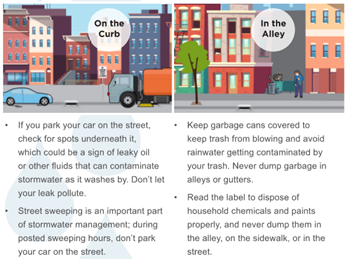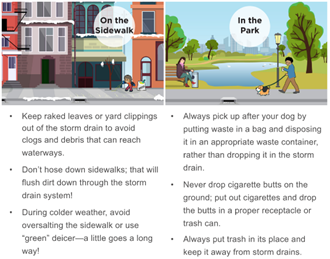Public Education, Outreach, Participation, and Involvement
What is Storm Water?
Storm water runoff is part of the natural hydrologic process and occurs when rainwater that does not infiltrate into the ground flows into water bodies such as creeks, lakes, streams, or rivers. In suburban areas, the storm water runoff often has the benefit of passing through naturally vegetated areas, which slows down the velocity of the water and ultimately filters it for pollutants and sediments. In urban settings, however, natural vegetation and topography have frequently been altered to prevent storm water from naturally soaking into the ground and so it is most often carried by storm drains.
When the drainage pattern of a watershed is altered with the addition of impervious surfaces such as driveways, parking lots, and buildings, flows increase in concentration and velocity and pick up sediments and pollutants from land surfaces at an increased rate. Storm water that flows through urbanized areas to receiving waters is called "urban storm water runoff” or “urban runoff."
Vanderburgh County has developed a storm water program that manages the pollutants and impacts from urban storm water runoff. The program includes education, storm water quality and quantity measures.

Pollutants
Urban runoff is known to carry a wide range of pollutants including:
- Heavy metals
- Nutrients
- Pathogens
- Petroleum hydrocarbons
- Sediments
- Synthetic organics such as pesticides
- Trash and debris
Once pollution reaches water bodies, it can harm aquatic life, damage ecosystems, and even end up in water used for drinking or recreation. Protecting our water bodies from all sources of contamination can be accomplished through the cooperation of citizens, government, and businesses.
Community Impacts
Pollutants in urban runoff could negatively impact the vitality of our municipality on many levels. Pollutants in urban runoff can:
- Alter the physical, chemical, and biological characteristics of water bodies to the detriment of aquatic and terrestrial organisms.
- Make streams and rivers unsightly or unsafe for human contact.
- Negatively impact water recreation, fishing, tourism, and aquatic habitat.
In some cases, pollutants of concern may not even be visible to the naked eye.


Provided by EPA: Be Stormwater Smart
Public Education
Vanderburgh County is promoting pollution prevention activities and education as part of the MS4 program. The below educational materials are available at the Vanderburgh County Courthouse:
Storm Water Pollution Prevention: Protecting Your Waterways
Pet Waste and Water Quality
Spotting Illicit Discharges
The following additional educational resources are available for viewing to learn more about storm water.
- Blue is the New Green - YouTube. Tippecanoe County Partnership for Water Quality. March 2015. Duration: 10:11. Video for the public on the right things to help protect our environment.
- Water Quality Education by The Clean Water Education Partnership - YouTube. Town of Cary, North Carolina. January 2018. Duration: 2:42. Video on what you can do to maintain water quality.
- Freddy the Fish Teaches About Storm water - YouTube. North Central Texas Council of Governments – Environment and Development. December 2014. Duration: 4:28. Freddy the Fish instructs kids about what happens to rain after it hits the ground, where storm drains lead to, and what we can do to help prevent water pollution
- Explaining Storm Water Runoff - YouTube. The Watershed Institute. Original video produced by the West Michigan Environmental Action Council for the City of Grand Rapids, MI. June 2018. Duration: 1:35.
What can you do to prevent storm water pollution?
- Clean up your property. Properly dispose of outdated or unused household chemicals stored in your basement, garage, or barn by taking them to the Vanderburgh County Solid Waste Management District (SWMD). Do not store these materials outdoors.
- Recycle used oil, automotive fluids, batteries, and other products. Do not dispose of hazardous products in storm drains, alleys, or the ground. This pollutes the water supply.
- Reduce the number of fertilizers, pesticides, or other hazardous chemicals that you use. Buy only what you need so that you do not have to dispose of leftovers. Read all the labels and follow directions.
- Sweep up debris, rather than hosing down areas.
- Clean up after your pet and dispose of pet waste in a trash container or toilet. When left outdoors, pet waste contributes bacteria and nutrients to storm water. Learn why this is important.
- Use a commercial car wash or wash your car on an unpaved surface to reduce the amount of dirty, soapy water entering storm drains and waterways.
- Cover piles of soil and mulch being used for landscaping projects.
- Prevent debris from entering nearby storm drains when conducting outdoor home improvement or landscaping projects.
- If you have a septic system, have it serviced regularly. Make sure it is not connected to the storm sewer or polluting a creek or body of water.
- Drain your swimming pool only when a test kit shows non-detectable levels of chlorine and bromine.
- If you spill chemicals, oil, or fuel, clean it up with absorbent materials (for example kitty litter). Do not let it soak into the ground. Place absorbent in the trash.
- If you live next to a community pond, help maintain it. Learn more from this video: Stormwater Pond Maintenance for Homeowners.
Other Community Sources
Residential sites are not the only sources of storm water pollution. Commercial and industrial sites can produce litter, debris, sediment, and illicit discharges. Learn more by reviewing the quick storm water tips for businesses below:


